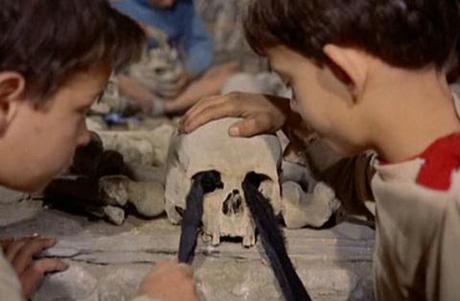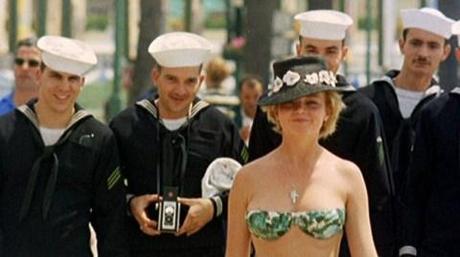
by Steve Habrat
By far one of the most bizarre and disturbing grindhouse films you will ever see is Mondo cane (A Dog’s Life), an exploitative “shockumentary” that spans the globe and brings you some of the most bizarre rituals and customs from all walks of life. In spurts, Mondo cane is jaw dropping, funny, appalling, and mesmerizing in the way it constantly flips on the viewer. Made in 1962 by Gualtiero Jacopetti, Paolo Cavara, and Franco Prosperi, Mondo cane sparked a whole subgenre of Mondo documentaries whose main purpose was to exploit death, sex, and taboos at all costs, sometimes even going so far as to stage what you are seeing. Mondo cane is also the film that inspired the infamous Faces of Death documentary, which claimed to feature real footage of people biting the dust (only bits and pieces of Faces of Death were real, the rest was staged.). Unlike most documentaries that strive to educate the viewer, Mondo cane is simply interested in making you squirm, all while a leering Narrator sarcastically explains and dissects what the viewer is looking at. One thing is certain; you won’t come away from Mondo cane a better person consumed by thought, just a little sickened and shaken up.
Mondo cane is comprised of several seemingly unrelated sequences of oddities from around the world. In this hour and forty-minute trip, the filmmakers invite you to spend time with a “cargo cult” at Port Moresby, New Guinea, take in the nuclear contamination on Bikini Atoll, sip a few drinks in a rowdy German beer hall, step into a death house in Singapore, witness a Hula Dance in Honolulu, stop by a Good Friday procession that finds the male participants beating their bare legs with broken glass in Italy, and watch the beheadings of bulls in Nepal. Some of the sights are comical and some are guaranteed to stick with you the rest of your life, but it is truly a journey unlike any other.
As Mondo cane flows along, it becomes increasingly clear what the filmmakers are trying to convey to the viewer. The world can be a sick, depraved, brutal, unforgiving, and downright confounding place to live. The viewer is invited by the Narrator (Stefano Sibaldi) to look down upon the sights you are seeing (at times, literally look down), almost with repugnance and amusement as Riz Ortolani and Nino Oliviero’s dreamy score hums in the background. Even though we never see the Narrator, you can just visualize him sitting atop a swanky tower, dressed in a tuxedo, and sipping a martini as he chuckles over manhunting in New Guinea and swallows back his lunch as pigs are mercilessly slaughter by a primitive tribe for a big feast. The filmmakers slyly edit the sequences of primitive tribes beating and killing animals with footage of a flashy American pet cemetery, where the camera lingers on the tears of a woman burying her four legged companion, and geese being force fed for foi gras in France. According to Jacopetti, Cavara, and Properi, we are the true brute savages built for their own queasy entertainment.

As far as deep analysis goes, that is about all I can come up with for Mondo cane. It quickly becomes clear that the film is in love with irony (women go to a gym to loose weight in America while tribeswomen are force fed so they can marry the dictator of a tribe) and it gets even bigger kicks out of peering upon death and suffering. The exploration of the Death House in Singapore, a place where the homeless and elderly are left to live out their final hours, is every bit as disturbing as it sounds. Another shock comes when Gurkha soldiers behead bulls with one swipe of a machete, all while the camera pans down to capture the flowing gore at their feet. You will also cover your eyes as the religious men in Italy beat their legs to a bloody pulp for the Good Friday procession. Perhaps worst of all is seeing a man be gored nearly to death by a bull in Portugal, the camera just staying on the scene long enough to see a few people run out and clear the body from the street. The filmmakers have the good sense to not linger too long on the human death but they sure do make up for it with how much animal cruelty they show to the viewer. Dogs are killed and boiled, pigs are beaten with large clubs, sharks have sea urchins shoved down their throats, and snakes have their skin ripped off. It is almost a relief (but honestly no less humane) when we get to Italy and we see chicks being dyed pastel colors for Easter.
There certainly is a playful side to Mondo cane but even these scenes have a vaguely mean-spirited and perverse echo to them. The scenes in the German beer hall are comical but also pathetic as people stumble home, urinate in the street, vomit, and get into nasty fistfights. Another lighter moment comes when we arrive in Sydney, Australia, for a Life Saver Girls competition, where beautiful swimsuit clad women “save” male swimmers, drag them to the beach, and give them CPR, all while the camera pans down to the male’s crotch. You get the impression that some of the perversion comes from the deeply troubled Jacopetti, who was more than familiar with perverted scandals at the time, even landing in a Hong Kong jail for three months after he was caught with two underage Chinese prostitutes, ages 10 and 11. While this sinister perversion is merely hinted at in Mondo cane, it would come to a head in future installments of the Mondo series. If you can believe it, Riz Orolani and Nino Oliviero’s theme song for the film, “Home,” managed to earn an Academy Award nomination. Overall, Mondo cane was immensely popular when it came out and it certainly caused quite a stir when it hit theaters. Looking at it today, the film lacks profundity, which severely wounds it, but it still manages to pack a punch and, in true grindhouse fashion, will make you feel a bit sleazy while watching it. This is an essential film for exploitation fans and a pass for anyone else.
Grade: C+
Mondo cane is available on DVD.
